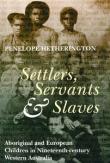 7334154309251605232.jpg
7334154309251605232.jpg
 Settlers, Servants and Slaves: Aboriginal and European Children in Nineteenth-century Western Australia
single work
Settlers, Servants and Slaves: Aboriginal and European Children in Nineteenth-century Western Australia
single work
 7334154309251605232.jpg
7334154309251605232.jpg
 Settlers, Servants and Slaves: Aboriginal and European Children in Nineteenth-century Western Australia
single work
Settlers, Servants and Slaves: Aboriginal and European Children in Nineteenth-century Western Australia
single work
'Settlers, Servants and Slaves documents the exploitation of both Aboriginal and European children by the settler elite of nineteenth-century Western Australia. In a struggling colony desperately short of labour, early settlers relied on the labour of children—their own and other people’s.'
'Convicted and neglected children from the poorest sections of this divided society were placed in institutions, where they were trained to become a useful part of the work force. Education services developed only slowly, and there was no system of secondary education provided by the government in the nineteenth century.'
'From the 1870s, Aboriginal children were widely ‘employed’, in a complex web of contract and apprenticeship law, in the pastoral and pearling industries in the North West. Often kidnapped by ‘blackbirders’, these children received no wages and had no opportunity to attend school.'
'Settlers, Servants and Slaves also shows how concern over ‘the problem’ of children of mixed descent in the last decade of the nineteenth century was to provide the rationale for infamous twentieth-century ‘solutions’: the removal of children from their parents and the establishment of Aboriginal Reserves.' (Source: Publisher's website)
'The author has bravely and thoroughly tackled a group of very embarrassing and difficult topics. Embarrassing, because we do not like to admit that Australians could ever have been as non-egalitarian, nor as racist, as she shows them to be. Difficult, because most of the evidence must come from official documents, which reflect official, that is, ‘settler’ attitudes, rather than the painful experiences of the young kin, servants and ‘slaves’ who had no opportunity to recount their own tales. Rarely can we detect the authentic voices of the little ten-year-olds who scrubbed and dug and weeded and washed under guise of being taught to become useful members of society.' (Introduction)
'The author has bravely and thoroughly tackled a group of very embarrassing and difficult topics. Embarrassing, because we do not like to admit that Australians could ever have been as non-egalitarian, nor as racist, as she shows them to be. Difficult, because most of the evidence must come from official documents, which reflect official, that is, ‘settler’ attitudes, rather than the painful experiences of the young kin, servants and ‘slaves’ who had no opportunity to recount their own tales. Rarely can we detect the authentic voices of the little ten-year-olds who scrubbed and dug and weeded and washed under guise of being taught to become useful members of society.' (Introduction)